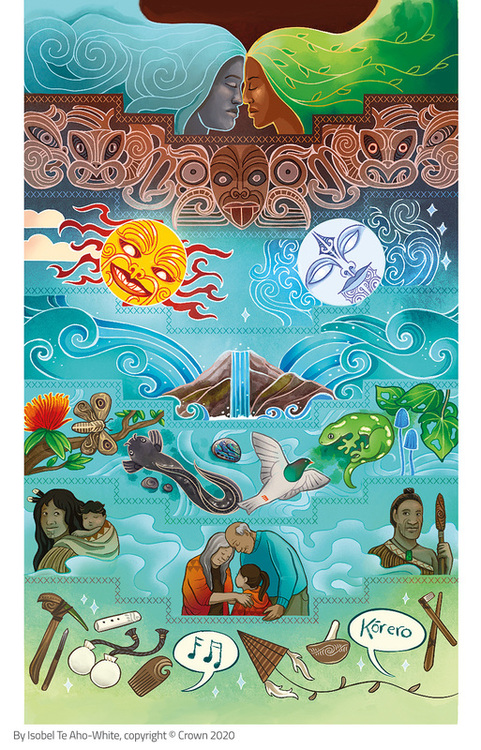In te ao Māori, all animals have mana by virtue of being loved descendants of ngā atua and must therefore be treated with respect. This article explores key ethical concepts that underpin Māori perspectives of animal ethics.
The following text is an excerpt from Exploring the Three Rs of Animal Ethics with Māori Ideas (a version of the text is available as a PDF in te reo Māori only or a bilingual version).
Key Māori concepts embody Māori difference in the intellectual plane – they are ancient indigenous concepts. Some of these concepts are shared across many related cultures of the South Pacific, with no English equivalents. Hence the term ‘tapu’ (originally meaning ‘in the presence of ngā atua’) has been appropriated intact into international English as ‘taboo’ (from the Tongan cognate tabu), while ‘mana’ (originally meaning ‘the ability to maintain balance with ngā atua’) has been included whole in New Zealand English.
Māori ethical concepts
To understand the Māori ethical concepts depends on understanding the Māori concept of a person as being composed of two parts – the physical (tinana or waitahi) and the metaphysical (wairua). The primordial forces are referred to as ngā atua. These metaphysical-spiritual aspects bring in mauri, hau (vitality), wehi (respect for ngā atua) and ihi (energy), but these concepts make sense only within an overall comprehension of te ao Māori, starting with the master concept of whakapapa.
An important disclaimer is to acknowledge that the explanations of Māori concepts in the interactive below are simple introductions, certainly not definitive. The aim is to consider each concept in an introductory way in relation to an overall Māori world view. Some of the concepts feature contextual insights from Māori experts who work with live animals.
Whakapapa forms the base of a simple model of Māori thought. Standing on whakapapa are the central ontological concepts of tapu and mana. The third layer consists of the triadic Māori ethical values – pono, tika and aroha.
Taken together, these six key Māori concepts structure a world view that somewhat differs from the standard Western paradigm of reality. Here, the aim is to highlight conceptual differences between Māori and Western knowledge – this emphasis on difference is not to be taken as anti-science or anti-Western. As explained in the article Māori concepts for animal ethics – introduction, this work is motivated by wanting to contribute towards better science and better animal ethics.
The concept of whakapapa
The concept of whakapapa provides a basis for understanding human-animal relationships, which acts as a rationale for humans to respect the animals with whom we share our homelands and world.
Related content
Māori concepts for animal ethics – introduction brings together resources that explore animal ethics with a kaupapa Māori approach. Other resources include:
- Theories of animal ethics
- The Three Rs of animal ethics
- How do Māori ideas relate to animal ethics?
- Dr Kimiora Hēnare
- Dr Leilani Walker
- Professor Eloise Jillings
- Hilton Collier
- Te Winiwini Kingi
- Rauhina Scott-Fyfe
For an overview of the research and resources looking at Māori concepts for animal ethics view our recorded webinar with Dr Georgina Tuari Stewart.
The Hub has extensive resources curated under the topic Ethics and science. Use the filters to narrow your search.
Māori knowledge of animals is an introduction to Māori knowledge of a selected sample of animals indigenous to Aotearoa. Mātauranga Māori about animals known to tūpuna is presented in six groupings:
- Kurī
- Kiore
- Ngā manu a Tānemahuta (featuring pīwakawaka, tūī, kererū, rūrū, kōtare, tītī and toroa)
- Ngā ika a Tangaroa (featuring makō and tohorā)
- Ngārara – te aitanga a Punga
- Te aitanga pepeke.
Activity ideas
Animal ethics – creating texts has topic suggestions for exploring some of the key concepts featured in this suite of resources.
The Three Rs of animal ethics – crossword puzzles supports making meaning of text and using content vocabulary. Puzzles are in English and te reo Māori.
Explore animal ethics via the context of roaming and/or feral house cats:
Acknowledgement
This content has been developed by Professor Georgina Tuari Stewart (Ngāti Kura, Ngāpuhi-nui-tonu, Pare Hauraki), Auckland University of Technology, and Dr Sally Birdsall, University of Auckland, with funding and support from the Ministry for Primary Industries – Manatū Ahu Matua and the Australian and New Zealand Council for the Care of Animals in Research and Teaching (ANZCCART).



